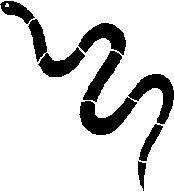|
DOMAIN
-
Eukarya
Domain is the broadest classification of an
organism. Domain Eukarya is divided into four kingdoms, Protista,
Animalia, Plantae and Fungi. Eukarya is characterized by having complex
cells, membrane bound organelles, and the genetic material is located
inside the nucleus.
KINGDOM -
Animalia
Members of the
kingdom Animalia lack a cell wall that is found in plants and are
heterotrophic feeders. Their food is ingested/digested within an
internal cavity and their bodies are made up of millions of cells organized into
tissues which are then organized into organs that serve for a specific
purpose to the organism.
PHYLUM
- Chordata
Chordates have a structure known as a
notochord, which is a rod that extends the entire length of chordates
fully developed bodies helping support the organism during locomotion.
They have bilateral symmetry, a segmented body, 3 germ-layers (with a
well developed coelom), a complete digestive system, a closed
circulatory system with ventral heart, a hollow nerve chord and a bony
or cartilaginous skeletal system.
SUBPHYLUM
-
Vertebrata
All vertebrata share a vertebral
column that runs from head to tail forming the main skeletal axis of the
body. It takes the role of the notochord and acts to strengthen it for
locomotion. Their muscles are attached to bone, a developed digestive
system is present with 2 kidneys to get rid of wastes. They have a 2-4
chambered heart that pumps blood containing hemoglobin, red/white blood
cells and many other blood elements. There are usually two sexes to
produce offspring.
CLASS
-
Reptilia
A major characteristic of all
reptiles is that there eggs are protected by an extra membrane. They have
have lungs instead of gills and a 3 or 4 chambered heart. They also have
acquired epidermal scales.
|


